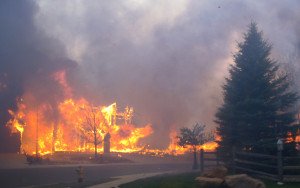

A new study of Colorado’s devastating 2012 Waldo Canyon wildfire demonstrates that prompt and effective action can significantly change the outcome of fires that occur in areas where residential communities and undeveloped wildlands meet. The study by the U.S. Department of Commerce’s National Institute of Standards and Technology (NIST) is the most comprehensive examination in history of a wildland urban interface (WUI) fire.
“WUI fires are very different from earthquakes, hurricanes and tornados where the hazard cannot be controlled,” said NIST fire researcher and principal investigator Alexander Maranghides. “Our study showed that WUI fires also are distinct from either urban or wildland fires alone. We provide strong evidence that defensive measures designed specifically for the wildland urban interface and administered early can significantly reduce destruction and damage.”

For example, the study found that because the Waldo firefighters tailored their response to the specific WUI conditions, 75 percent of their attempts to extinguish ignited structures were successful and 79 percent of their efforts at fire containment were successful in preventing rampant fire spread.
The details of the NIST study are described in a report released during the Fire Chiefs White House Roundtable on Climate Change Impacts at the Wildland Urban Interface.
The number of WUI fires, particularly in the western and southern regions of the United States, has grown as housing developments push into wilderness areas. According to the Bureau of Land Management’s National Interagency Fire Center (NIFC), the 10 years since 2002 saw an annual average of nearly 71,000 WUI fires recorded and 1.9 million hectares (4.7 million acres) burned. Today, more than 32 percent of U.S. housing units and one-tenth of all land with housing are situated in the nation’s 89 million hectares (220 million acres) of WUI, putting approximately 72,000 communities and more than 120 million people at risk.
The physical and monetary toll from WUI fire destruction is staggering. The NIFC calculates that nearly 39,000 homes—more than 3,000 per year—were lost to wildfires from 2000-2012 and that federal, state and local agencies spent an average of $4.7 billion annually during that period on WUI fire suppression.
The Waldo Canyon WUI fire started on June 23, 2012, just southwest of Colorado Springs, Colo. By the time the blaze was declared contained on July 10, 2012, it left two people dead, destroyed 344 homes and damaged more than 100, burned 7,384 hectares (18,247 acres) and cost an estimated $454 million in insured losses.
The NIST study, conducted in collaboration with the U.S. Department of Agriculture’s U.S. Forest Service (USFS) and the federal Joint Fire Science Program, documented and assessed the chronology, behavior and outcomes of the fire, as well the firefighting activity against it.
In their investigation, Maranghides and his colleagues focused on the Mountain Shadows community in Colorado Springs, the location for all of the homes destroyed in the Waldo Canyon fire. The scientific analysis of the fire’s impact on Mountain Shadows and the effectiveness of defensive measures taken to suppress it took two years to complete. Researchers spent 4,500 hours on data collection, conducted more than 200 technical discussions with first responders and made more than 4,500 distinct fire and defensive action observations.
Along with the most detailed timeline for a WUI fire ever created, the Waldo Canyon investigation yielded 37 technical findings that served as the basis for 13 technical recommendations aimed at improving community resilience to wildfires.
Among the key findings:
Among the key technical recommendations:
NIST’s work on WUI fires is part of its ongoing programs for enhancing disaster resilience by reducing the risks of fires, earthquakes, windstorms and coastal inundation on buildings, infrastructure and communities, including facility occupants/users and emergency responders.
Source: NIST